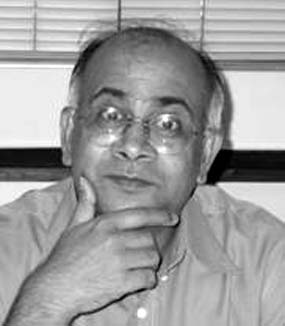
Shanti Swarup Gupta
 المؤلف:
N Balakrishnan and K J Miescke
المؤلف:
N Balakrishnan and K J Miescke
 المصدر:
Preface: In Memory of Dr Shanti Swarup Gupta, J. Statist. Plann.
المصدر:
Preface: In Memory of Dr Shanti Swarup Gupta, J. Statist. Plann.
 الجزء والصفحة:
...
الجزء والصفحة:
...
 16-3-2018
16-3-2018
 5113
5113
Born: 15 January 1925 in Saunasi, Mainpuri, India
Died: 11 January 2002 in West Lafayette, Indiana, USA

Shanti Swarup Gupta was brought up and educated in India. He studied for a Master's Degree at the University of Delhi and then began teaching there. After several years, he was awarded a Fulbright Scholarship in 1953 which enabled him to read for a doctorate in the United States. He studied at the University of North Carolina at Chapel Hill with Raj Chandra Bose as his thesis advisor. He was awarded his doctorate in 1956 for his thesis On a Decision Rule for a Problem in Ranking Means. He then began research in statistics at Bell Laboratories, in Allentown, eastern Pennsylvania. These Laboratories were set up to develop equipment and systems manufactured by AT&T but they became involved in a wide range of basic and applied research in different areas. For example in the year which Gupta was awarded his doctorate, three scientists at the Bell Laboratories were awarded a Nobel Prize in Physics for inventing the transistor.
Gupta's first publications include the following with Milton Sobel: On a statistic which arises in selection and ranking problems (1957); On selecting a subset which contains all populations better than a standard (1958); On the distribution of a statistic based on ordered uniform chance variables (1958); and Selecting a subset containing the best of several binomial populations (1960). During these early years of his research he also published Moments of order statistics from a normal population (1959) written jointly with his Ph.D. supervisor, and the single authored paper Order statistics from the gamma distribution (1960). As an example we look briefly at the type of problems that are studied in On selecting a subset which contains all populations better than a standard.
The idea is to look at n populations and one standard population, all having the same type of distribution. One of the n populations is 'at least as good as the standard population' for a particular parameter if the value of that parameter is at least as high in that population as in the standard one. The authors then investigate how, given a fixed probability p, one can choose a subset of the n populations so that the probability is at least p that the subset contains all those at least as good as the standard population. A range of different distributions and parameters are discussed such as the populations all have normal distributions with the same variance and the parameter is the mean.
Gupta publication record is exceptional containing over 200 items. Among these are two important books. The first of these is Multiple decision procedures: theory and methodology of selecting and ranking populations written jointly with S Panchapakesan and published in the Wiley Series in Probability and Mathematical Statistics in 1979. Khursheed Alam, reviewing the text, wrote:-
This book contains a comprehensive collection of published literature in multiple decision theory, dealing with problems of ranking and selection. The book deals primarily with the subject of ranking and selection. However, a section of the book covers related areas, such as the estimation of ordered parameters. The material presented in the book has been properly arranged and carefully written so that the book serves as a textbook for graduate students as well as a reference book. The content of the book is not only pleasant to read but it is also motivating.
The second important text is Multiple statistical decision theory: recent developments written jointly with Deng Yuan Huang and published in 1981. The same reviewer writes:-
In this monograph the authors present a short discussion of the statistical theory of multiple decision rules with particular reference to the subject of ranking and selection.
Gupta held academic posts at universities such as the University of Alberta and New York University where he worked at the Courant Institute. He also held visiting lectureships at Stanford University, the University of California at Berkeley and the Technical University of Darmstadt in Germany. In 1962 he was appointed as Professor of Statistics and Mathematics at Purdue University, a position he held until his death. At Purdue he founded the Department of Statistics in 1968 and served as the first Head of Department from its foundation until 1995.
For his many contributions to statistics, Gupta was honoured by election as a fellow of several societies such as the American Association for the Advancement of Science, the American Statistical Association, and the Institute of Mathematical Statistics (for which he served a term as president). The Indian Statistical Association elected him to honorary membership. He also served as Editor-in-Chief of the Journal of Statistical Planning and Inference.
Gupta married Marianne Heinicke; they had one daughter Maya.
Articles:
- N Balakrishnan and K J Miescke, Preface: In Memory of Dr Shanti Swarup Gupta, J. Statist. Plann. Inference 136 (7) (2006), 1985.
- J J Deely, Shanti S Gupta, J. Statist. Plann. Inference 136 (7) (2006), 1999-2003.
- S Panchapakesan, Shanti Swarup Gupta : his life (1925-2002) and work, J. Statist. Plann. Inference 136 (7) (2006), 1986-1998.
- S Panchapakesan and T J Santner, Shanti S Gupta : an appreciation, Amer. J. Math. Management Sci. 5 (3-4) (1985), 345-369.
- Shanti S Gupta - career and accomplishments, in Advances in statistical decision theory and applications (Birkhäuser Boston, Boston, MA, 1997), xix--xl.
 الاكثر قراءة في 1925to1929
الاكثر قراءة في 1925to1929
 اخر الاخبار
اخر الاخبار
اخبار العتبة العباسية المقدسة


